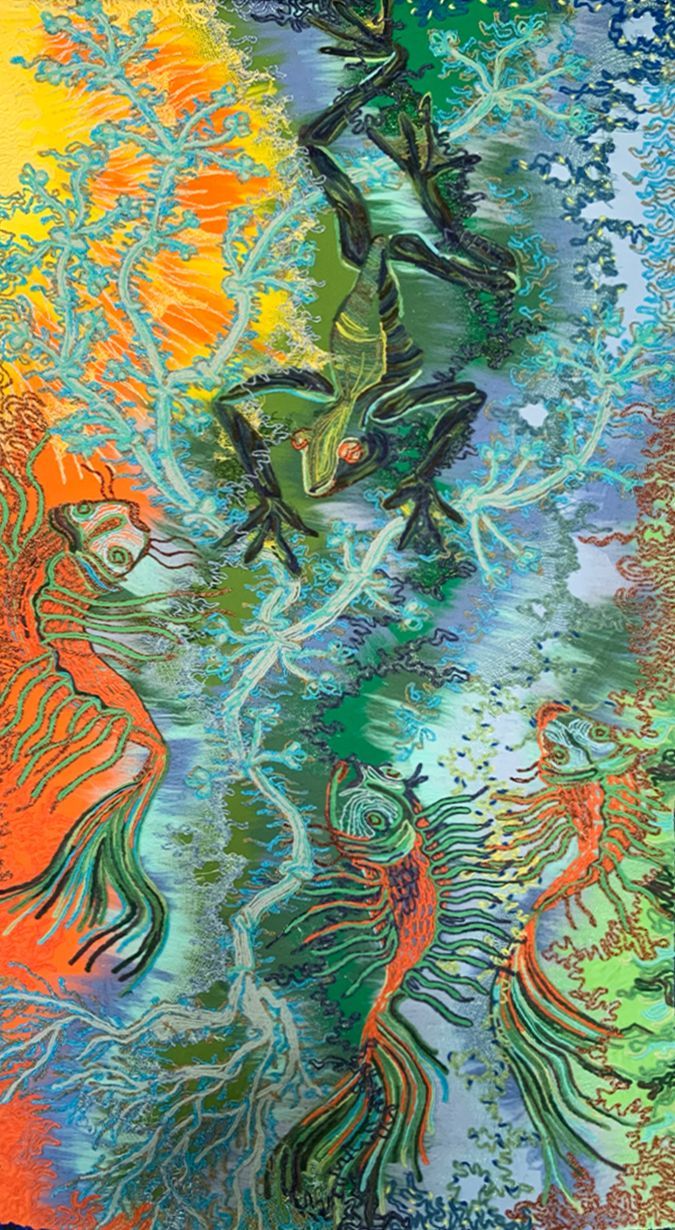4 tapestries
Ruminations on the Tree of Life
Paradise Regained, 2024
I The Dream of The Rood
II ΤΗΙ ΚΑΛΛΙΣΤΗΙ
III Gaokerena
IV Kalpavriksha
Four works present multiple visions of the ‘Tree of Life,’ an archetypal symbol deeply rooted in numerous mythologies and religious traditions, and as a motif a recurring subject in d'Angelino Tap's work. The collective title of the series references Paradise Regained, the "brief epic poem" by the English poet John Milton.
From the Anglican ministry of Great Britain
I saw in front of me a beautiful old English oak tree, its trunk was wide, and its roots spread all over the nations, As I looked, I could see the branches of one side of this tree reached up to the sky,
But on the other side I saw a large old branch, it was old and thick, but I could see it was bending towards the ground, then I saw that many brambles were reaching up from the ground and pulling it down this continued for some time until I heard an almighty crack!
I then looked and saw this beautiful old oak had been split in half, the old branch was now entirely on the ground, and quickly bramble grew round the branch, as this happened the branch grew black and died. Yet, because of all the bramble, it looked like it had many leaves, but it was not the tree branch that lived. It was the brambles and thorns that did.
As I looked, I saw the other half of this old tree struggled to live for a short time but then out of the break new fresh branches began to grow with fresh new leaves, surface, it will appear to be alive but its life will be death. What’s left will be shaken, and, for a short time, it will struggle to live, but then out of the break new life shall come forth.
Paradise Regained | The Dream of the Rood
The Dream of the Rood is one of the earliest Christian poems in the corpus of Old English literature. The word rood is derived from the Old English rōd, meaning 'pole' or, more specifically, 'crucifix'. Preserved in the 10th-century Vercelli Book, the poem may date as far back as the 8th century and is regarded as one of the oldest surviving works in Old English.
The poem begins with the narrator recounting a dream or vision in which he speaks to the Cross upon which Jesus was crucified. At first, the dreamer sees the Cross adorned with precious gems, recognizing his own wretchedness in contrast to the glory of the tree. However, he soon notices that beneath the beautiful stones, the Cross is stained with blood. In a later stanza, the Cross itself recounts the Crucifixion. A story told from the perspective of the Cross.
Paradise Regained | ΤΗΙ ΚΑΛΛΙΣΤΗΙ
"The Fairest" — In Greek mythology, the Tree of Life is represented by a pomegranate tree, guarded by snakes. The pomegranates on this tree are believed to possess divine and magical powers. According to myth, during the wedding banquet of Peleus and Thetis, hosted by Zeus, the king of the gods, Eris, the goddess of discord, was not invited due to her disruptive nature. In retaliation, Eris arrived uninvited and threw a golden apple into the ceremony, inscribed with the words "ΤΗΙ ΚΑΛΛΙΣΤΗΙ," meaning "To the fairest." Three goddesses claimed the apple, a rivalry that eventually sparked the Trojan War.
Paradise Regained | Gaokerena
The Gaokerena is a large, sacred Haoma tree in Iranian mythology. The white Haoma is believed to possess the power to ensure the continuance of life in the universe through its vitality. Ahriman, a destructive force in the pre-Persian pantheon, created a frog to invade and destroy the tree, with the aim of preventing all trees from growing on earth. In response, Ahura Mazda, Ahriman’s counterpart, created several kar-fish to guard the tree. These fish continuously watch the frog, remaining vigilant and ready to act if it threatens the tree.
Paradise Regained | Kalpavriksha
Kalpavriksha, in Hindu tradition, is known as the Tree of Life or the "World Tree" and is mentioned in the Vedic scriptures. In the earliest accounts from these ancient texts, Kalpavriksha is described as emerging from the primal waters during the "churning of the ocean of milk," along with Kamadhenu, the divine cow that fulfills all desires. The tree is also symbolically associated with the Milky Way or the birthplace of the star Sirius. Indra, the king of the devas, is said to have taken the Kalpavriksha to his heavenly abode, where he planted it in his paradise.





